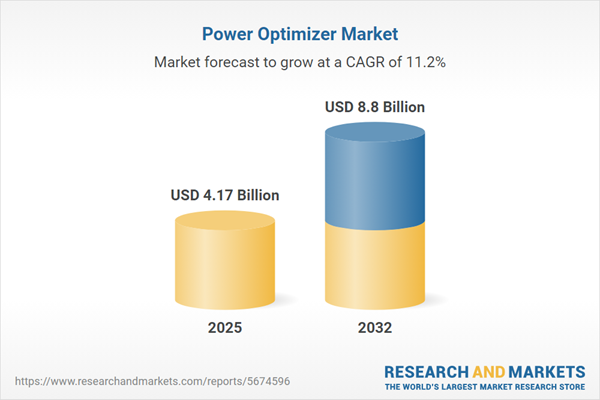Speak directly to the analyst to clarify any post sales queries you may have.
The power optimizer market is becoming a crucial element in the evolution and performance optimization of solar and hybrid energy systems. Senior leaders evaluating investments and strategy in distributed energy benefit from understanding this ecosystem’s drivers, competitive dynamics, and regulatory factors.
Market Snapshot: Power Optimizer Market Size and Growth
The Power Optimizer Market grew from USD 3.75 billion in 2024 to USD 4.17 billion in 2025. Ongoing innovation, intensifying regulatory requirements, and swift technology adoption will support a projected CAGR of 11.24%, propelling the market to USD 8.80 billion by 2032.
Scope & Segmentation
This research report provides a comprehensive analysis across a broad spectrum of market segments, regional dynamics, and leading players, allowing stakeholders to pinpoint high-yield opportunities and strategic risks.
- End User: Commercial, Industrial, Residential
- Technology: Maximum Power Point Tracking (Mppt), Pulse Width Modulation (Pwm)
- Application: Hybrid Energy Systems, Solar PV (Rooftop PV, Utility Scale PV), Wind Energy
- Installation Type: Grid Tied, Off Grid
- Distribution Channel: Offline, Online
- Power Capacity: 500 to 1000W, Above 1000W, Up to 500W
- Regional Coverage: Americas (North America – United States, Canada, Mexico; Latin America – Brazil, Argentina, Chile, Colombia, Peru); Europe, Middle East & Africa (Europe – United Kingdom, Germany, France, Russia, Italy, Spain, Netherlands, Sweden, Poland, Switzerland; Middle East – United Arab Emirates, Saudi Arabia, Qatar, Turkey, Israel; Africa – South Africa, Nigeria, Egypt, Kenya); Asia-Pacific (China, India, Japan, Australia, South Korea, Indonesia, Thailand, Malaysia, Singapore, Taiwan)
- Leading Companies: SolarEdge Technologies, Tigo Energy, Huawei Digital Power Technologies, Shenzhen Hoymiles Power Electronics, APsystems, SMA Solar Technology, Fronius International, Delta Electronics, GoodWe, Shenzhen Growatt New Energy Technology
Key Takeaways for Senior Decision-Makers
- Power optimizers have shifted from being optional enhancements to integral solutions, providing module-level performance, safety, and analytics for distributed energy assets.
- Integrated hardware-software platforms allow real-time system monitoring and predictive maintenance, improving both asset uptime and overall lifecycle value.
- The push towards smart grid integration increases the relevance of device-level intelligence, enabling support for ancillary services and compliance with evolving grid codes.
- Regional market dynamics are influenced by policy, incentives, and energy access priorities, making adaptation of offerings and supply chain strategy essential for market entry and expansion.
- Segmented solutions for differing installation types, technology preferences, and power capacities enable stakeholders to address specific operational and regulatory requirements across geographies.
Impact of 2025 United States Tariffs on the Power Optimizer Supply Chain
Recently enacted tariffs on imported power optimizer components in the U.S. have intensified supply chain and pricing pressures. Companies are responding by adjusting procurement models, shifting manufacturing footprints, and focusing on system-level optimization to address added costs. These measures affect project timelines, regional sourcing, and cost competitiveness across multiple stakeholder groups.
Methodology & Data Sources
A rigorous methodology underpins this research, combining primary interviews with industry stakeholders and secondary analysis from established market sources. Data is validated through triangulation and expert review, providing a robust foundation for actionable insights.
Why This Report Matters
- Equips leaders with a clear view of technology advancements, segment relevance, and competitive environments to inform strategic investment and operational planning.
- Highlights market developments in tariffs, regulations, and global supply chains, enabling informed procurement and risk mitigation decisions.
- Supports benchmarking and partner selection by profiling major companies and mapping regional opportunity landscapes.
Conclusion
Power optimizers are pivotal to the advancement of distributed energy systems, driven by innovation, regulation, and the shift to smart grids. This report offers comprehensive analysis for stakeholders seeking to optimize market positioning and navigate future opportunities in the sector.
Additional Product Information:
- Purchase of this report includes 1 year online access with quarterly updates.
- This report can be updated on request. Please contact our Customer Experience team using the Ask a Question widget on our website.
Table of Contents
3. Executive Summary
4. Market Overview
7. Cumulative Impact of Artificial Intelligence 2025
Companies Mentioned
The companies profiled in this Power Optimizer market report include:- SolarEdge Technologies, Inc.
- Tigo Energy, Inc.
- Huawei Digital Power Technologies Co., Ltd.
- Shenzhen Hoymiles Power Electronics Co., Ltd.
- APsystems, Inc.
- SMA Solar Technology AG
- Fronius International GmbH
- Delta Electronics, Inc.
- GoodWe Co., Ltd.
- Shenzhen Growatt New Energy Technology Co., Ltd.
Table Information
| Report Attribute | Details |
|---|---|
| No. of Pages | 187 |
| Published | October 2025 |
| Forecast Period | 2025 - 2032 |
| Estimated Market Value ( USD | $ 4.17 Billion |
| Forecasted Market Value ( USD | $ 8.8 Billion |
| Compound Annual Growth Rate | 11.2% |
| Regions Covered | Global |
| No. of Companies Mentioned | 11 |









